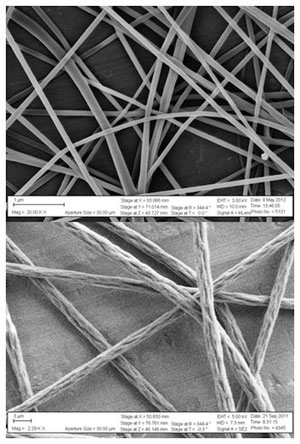| Mar 27, 2013 |
Polymer nanofibers for chemical and biological decontamination
|
|
(Nanowerk News) Chemical and biological threats pose a significant concern not only to the modern warfighter but an ever-increasing number of individuals and groups. This threat is compounded by the persistence of these agents and the possibilities of causing increased personnel exposure by the relocation of contaminated materials.
|
|
To combat this, NRL scientists are developing unique systems aimed at the spontaneous decontamination of a variety of materials via the incorporation of functional additives such as quaternary ammonium salt (QAS) biocides, polyoxometalates (POMs), fullerenes, and phthalocyanines capable of neutralizing chemical and biological agents.
|
 |
| Magnification of Electrospun Nanofibers: (Top) Nylon fibers electrospun from solution containing 1 weight percent (wt%) of a biocidal quaternary ammonium salt additive. (Bottom) Polycarbonate fibers electrospun from solution.
|
|
"Some of our previous work has utilized the incorporation of small amounts of these decontaminating agents into paints and coatings," said James Wynne, Ph.D., section head, Applied Concepts in Materials Section of the Chemistry Division. "Due to the promising decontamination performance the coatings experienced against a variety of pathogens and chemical agents, we are now extending the additive-derived decontamination capacity to include materials that cannot be painted or coated, such as polymer nano- and microfibers that can be utilized for a variety of applications such as garments."
|
|
NRL chemists have begun utilizing electrospinning—a technique using an electrical charge to draw very fine fibers from a liquid—to fabricate nearly monodisperse fibers ranging in diameter from 45 nanometers to three micrometers. A variety of polymers are co-electrospun with varying concentrations and structures of QAS POMs and other functional compounds.
|
|
Biological decontamination of QAS loaded Nylon 6,6 polymide fibers showed a 99.9999 percent reduction of viable S. aureus with increasing biocidal activity correlating well with increased biocide loading and surface biocide content. Separate systems of nylon fibers containing five percent of a nickel POM compound have shown over 50 percent decontamination of 2-chloroethyl phenyl sulfide (CEPS), a mustard simulant, with increased decontamination at even higher POM loadings.
|
|
Phthalocyanines, the newest compounds that have been synthesized at NRL, exhibit even greater decontamination capacity than that of POM compounds at only a fraction of the concentration. Examining the effect of nanofiber size on decontamination capacity has shown strong correlations between the surface area of the fibers and activity, demonstrating specific compositions experience well over 99.9 percent greater decontamination capacity when electrospun than the same materials cured as traditional coatings.
|
|
The wide variety of both commercially available and specially-synthesized polymers that have been examined by this group may also give rise to additional applications such as air and water filters that self-decontaminate against deadly pathogens.
|

